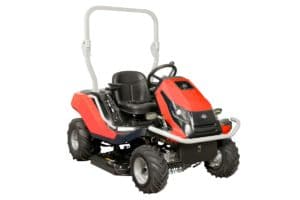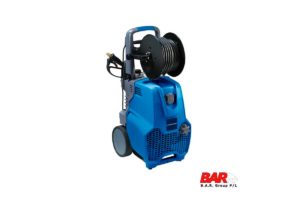 Families trapped in their homes. Trees coming straight at you while working. As a firefighter in frequently storm-hit Mississippi, Woodman Speights has plenty of experience working with chainsaws in tough conditions. Like the dangerous task of storm cleanup – something that should only be done by trained professionals. “I’ve seen some serious damage,” he says.
Families trapped in their homes. Trees coming straight at you while working. As a firefighter in frequently storm-hit Mississippi, Woodman Speights has plenty of experience working with chainsaws in tough conditions. Like the dangerous task of storm cleanup – something that should only be done by trained professionals. “I’ve seen some serious damage,” he says.
Woodman Speight, Age: 23, Profession: Firefighter at Starkville Fire Department, Hometown: Ponotoc, Mississippi
Cleaning up an area hit by a storm represents one of the most hazardous tasks when working with chainsaws. Statistically, there are more injuries during the clean-up process than during the actual storm. Woodman Speights and his colleagues at the Starkville Fire Department are always ready to go to work with their chainsaws close at hand. During his latest storm-related mission, the cleanup work was crucial to get to the emergency situation – a family home hit by a large oak tree.
“We had a call about a large tree coming in through the roof of a house. But to get there we had to clear the streets from trees that had fallen all over the place.”
Woodman’s crew used their chainsaws to clear the way. A task that included several challenges such as electrical fires, fallen wires and debris.
“The most important thing is to stay calm. If you start doing things without thinking, you will get hurt. And this is a very bad situation to get hurt in,” Speights says.
Thanks to volunteers who helped remove cut-off limbs and debris, the first part of the clean up was done in 30 minutes and the firefighters could enter the house. That’s when they discovered that the crown of the huge tree had completely blocked the hallway, trapping the family in one of the upstairs bedrooms.
“We started by checking the limbs for tension, but there wasn’t any. So we cut off the branches, opening up a path for the family.”
“The most important thing is to stay calm. If you start doing things without thinking, you will get injured.”
What is your most important piece of advice to fellow chainsaw users when it comes to storm cleanup?
“Always remember that if there’s any doubt that you will be able to handle the situation – don’t do it. If you feel like you might not be properly equipped or experienced enough and if it’s not a complete emergency, you should leave it to a professional.”
7 professional storm clean-up tips:
Before you start:
- Look Make an inventory of the damage. Are there any fallen wires or debris in or near the trees? Is there tension in the wood that will affect its movement?
- Talk Make sure everyone involved in the clean up are professionals who know what they’re doing. People who have undergone appropriate training should do this work.
- Escape plan Always ensure you have an escape route before you start working.
1. Take the right equipment
You need to make sure that you take the proper safety apparel for operating a chainsaw. You also need to regularly check the safety features of the equipment so that they’re up to speed. Also, take a first aid kit and extra fuel and oil for your equipment.
And remember, the very best thing to take when working with chainsaws is a companion. Always avoid working alone.
“We usually have a commander who assigns the team specific tasks. Often there are also volunteers helping out. It’s important that everyone involved communicates properly before the work starts, since it can be hard to hear anything over the sound of the chainsaw and the ear protection,” says Speights.
2. Planning your work
When approaching the storm-hit area, always take time to assess the situation. Are there any fallen wires or debris in the crowns of the trees? Is there tension in the trees and are there any uprooted trees? You should not attack the area before you have had a good look at what you have ahead of you. It is also very important that you plan an escape route, in case anything happens.
“The only time you want to rush during a clean up is when you see a tree falling towards you. That’s when you need to be able to just drop your saw and hit the escape route,” says Speights.
3. Cutting where there’s tension
One frequently occurring challenge when it comes to storm clean up is tension in fallen trees. Tension can cause unexpected movement when cutting the tree, making the limbs pop out and hurt you, or hit your equipment, or cause the trunk to move and make you stuck.
Speights explains how he attacks a fallen tree with tension:
“We start by cutting all the small branches off to get a better view of the situation. Then we take off as much weight as possible before cutting the limbs with tension. We continue to make a small cut on the tension side, to relieve a bit of tension, and slowly and in a controlled way make three to four additional small cuts until the tension is completely relieved. The important thing is to take it slowly and step-by-step.”
This is dangerous work that should only be done by trained professionals.
For excessive tension: Opening on the pressure side
A variation where you only saw from the inside of the arc (pressure side). Make a cut like an open directional notch with a larger opening angle. Saw a little at a time on both sides until the tension starts to release. The tension is released slowly under good control and direction. Be careful with the nose of the guide bar to avoid kickback.
For moderate tension: Open counter cut
- Cut an open directional notch on the inside of the arc of the curved trunk, to about one third of the trunk’s thickness.
- Remain on the inside of the arc and cut in small stages from the outside of the arc, in the centre of the notch, until the trunk breaks.
Fell in the correct sequence
Storm-felled trees are to be felled in the direction of the storm wind. Do not take any risks and ensure that you always have an escape route. Start with the top trees to reduce the risk of them falling into a dangerous position and entrapping you. The trees in the picture are brought down in the following order: 1, 2, 3, and 4.
- Leaning tree
- Broken tree, hanging/felled tree
- Lying tree uprooted
- Vertical broken tree, high stumps
4. Bringing down a leaning tree
Start by taking down the leaning tree. The tree’s roots are probably under strain and its position is unstable. For this reason you must never walk in the tree’s felling area. Fell the tree with a safe corner straight back or, on a steep slope, with a V-cut or deep V-cut. The tree will then fall slowly, and will be kept attached to the stump during the fall without splitting or hitting anything.
5. Bringing down broken trees with hanging tops
Families trapped in their homes. Trees coming straight at you while working. As a firefighter in frequently storm-hit Mississippi, Woodman Speights has plenty of experience working with chainsaws in tough conditions. Like the dangerous task of storm cleanup – something that should only be done by trained professionals. “I’ve seen some serious damage,” he says.
- Start by cutting off the top so that it is easier to turn.
- Turn the broken section down using a turning hook, turning strap or by pulling it loose with a machine.
- Now fell the high stump in the usual manner. But beware – the log usually falls quickly and may kick up at the butt end and roll erratically.
6. Handling uprooted fallen trees
Windfalls with large uprooted trees should never be cut at the butt end first if there is any risk that the root could kick over in your direction. If the entire tree must be processed with a chainsaw, it is best to start from the top. This releases any tension before you get to the roots. Start by limbing the tree so you can easily see if the trunk is under tension. Now measure the length of the first log from the top and cut the log there. Alternatively, cut as far as the “butt off” so the roots cannot kick up. Now use a tractor with a grapple loader or winch to tip back the uprooted tree with high stump.
Warning: When the trunk has been cut off, the uprooted tree must never be left standing. Failure to completely fell the tree could result in its falling on passers by, resulting in serious injury or death.
Cutting the root manually before machine harvesting must only be done when there is no risk of the uprooted tree turning over. You must also be in a safe position if the trunk kicks out.
When the trunk is cut at the root, it may move sideways at great force. Therefore, keep your retreat route behind you free. Stand with the uprooted tree on your left side and cut the trunk to your right, about 0.5 meters up the trunk. You now have protection for your legs if the trunk kicks out sideways when it is cut through.
7. Bringing down broken trees without hanging tops
Broken trees and high stumps are felled in the usual way, like a normal tree. But beware – the logs usually fall quickly and may kick up at the butt end and roll erratically.
Equipment when working in a storm-felled forest
- Full personal protective equipment
- First aid Kit
- Flourescent jacket
- Chainsaw with effective safety features
- Complete logger belt
- Combi can
- Axe
- Wedges to prevent jamming
- Breaking bar with longer handle
- Extra chains and guide bars
- Extra long guide bar to reach through from a safe position






































